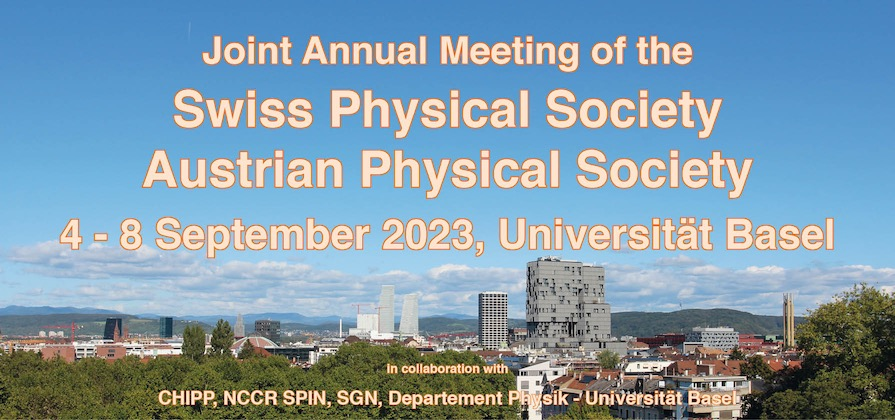Thermal motion of a room-temperature mechanical resonator typically dominates the quantum backaction of its position measurement. Optomechanics provides a path towards quantum control of the mechanical motion by dominating the thermal effects with optical backaction. In this work we design, fabricate, and characterize three different classes of nanomechanical resonators with Q factors...
We employ coherent feedback as strategy to improve quantum control of an optomechanical system, by implementing a feedback platform that avoids measurements and their associated decoherence. This is implemented via an optical light beam that sequentially interacts twice with a nanomechanical membrane placed inside an optical cavity. Theoretically this scheme allows for ground-state cooling...
We present the strain and magnetic field dependent photophysics of individual Nitrogen-Vacancy (NV) color centers in diamond from cryogenic to ambient conditions. Our experimental results and matching model predictions offer new insights into the structure of the NVs' excited states and its significant effect on the optical spin contrast, which directly relates to the performance of NV centers...
Integrated all-optical logic could define a new paradigm for computing architectures. Strong light-matter coupling based all-optical transistors exhibiting ultra-fast switching and room-temperature operation have recently been demonstrated using free-space optical setups. Here, we leverage silicon-on-insulator (SOI) technology to realize high-index contrast grating (HCG) as mirrors to form...
Chirality is a property of living organisms molecules, chemicals and drugs, which makes their detection and analysis an extremely important task in biology, chemistry, and pharmacology. One of the most well known methods for detecting chiral matter handedness is the measurement of circular dichroism (CD) that can be defined as the difference in the transmission of right- and left-handed...
Cesium lead halide perovskite quantum dots (QDs) have recently emerged as promising platform for quantum light sources. They exhibit exceptional photoluminescence properties due to the emission from a bright triplet exciton state with dominantly but not fully linear emission polarization.
Here, we are investigating the polarization properties of individual cesium lead halide perovskite QDs by...
Input–output theory is a well–known tool in cavity elec-
trodynamics and ubiquitous in the description of quantum
systems interacting with the environment. We present a
new approach to input–output theory using the Keldysh path
integral formalism. This approach allows us to get perturbative results for non–linear systems.
We apply this novel approach to a single mode in a cavity...
We report on first single-grating diffraction of molecular matter-waves at a continuous 266nm optical grating. While pulsed UV gratings are already used in molecular interferometry, continuous ones have so far been hindered by lack of high-power lasers and fast degradation of UV optics in vacuum. Our focus is on applications for quantum-assisted measurements of molecular electronic properties,...
In the regime of strong light-matter coupling, polaritons are formed that are hybrids of a cavity mode and a matter excitation. Recently, magnon-polaritons were researched using ferromagnets in the microwave range. Exploring antiferromagnets rises magnon-polariton frequencies into the terahertz range. We report on coupling of antiferromagnetic resonance (AFMR) in two parallel-plane crystals of...
An array of closely spaced, dipole coupled quantum emitters exhibits collective energy shifts as well as super- and sub-radiance with characteristic tailorable spatial radiation patterns. As striking example we identify a sub-wavelength sized ring of exactly 9 identical dipoles with an extra identical emitter with a extra loss channel at the center as the most efficient configuration to...
Cavity QED systems have proved valuable for
quantum simulations, specifically for the long-range interactions that the cavity field mediates between the atoms.
We have realized a random spin model with atoms in a cavity where we introduce controlled disorder in the the atomic transition frequencies with a light-shift of the excited state. We study the competition between the collective...
Multiparticle interference phenomena have been crucial to the understanding of quantum physics. In two-particle systems, Hong, Ou, and Mandel showed how particles’ indistinguishability forbids retrieving information about the pairwise exchange process, playing a key role in witnessing interference. Contrarily, in systems of $N\geq3$ partially distinguishable particles, multiple interference...
We observe for the first time the famous Einstein-Podolsky-Rosen (EPR) paradox with two spatially separated, massive many-particle systems. We split a spin-squeezed Bose-Einstein condensate into two spatially separated parts, on which we perform independent spin measurements to demonstrate the paradox. Our results show that the conflict between quantum mechanics and the classical understanding...
According to the wave-particle duality (WPD), quantum systems show both particle- and wave-like behavior, and cannot be described using only one of these classical concepts. The WPD implies that comparison to one classical model is generally insufficient; one wave and one particle model should be considered. We exploit this insight, contrasting a bosonic quantum heat engine with particle and...
Understanding scaling laws of entropies and mutual information has benefited studying correlated states of matter, quantum field theory, and gravity. Measuring von Neumann entropy experimentally in quantum many-body systems is challenging. In my talk, I will present our measurements of von Neumann entropy of subsystems in an ultracold atom simulator of Klein-Gordon field theory, verifying a...
The ASACUSA-Cusp experiment aims to perform spectroscopy of the hyperfine structure of antihydrogen by producing a beam of cold, spin polarised, ground state antihydrogen.
Recently, a major technological milestone was achieved by the collaboration. Previously, it has not been possible to cool plasma below 130 K, however, a new electrode stack and coldbore with a focus on blocking microwaves...
